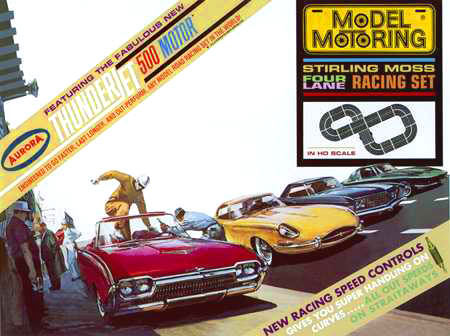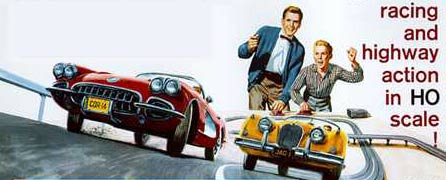|
To many of the '60s boys who
raced home slotcars, the second generation of Aurora's Model Motoring
cars, known as Thunderjet 500s, Thunderjets,
or simply T-jets, generates the best childhood memories
and is still the most enjoyable to race of the many styles and generations
of HO slotcars.
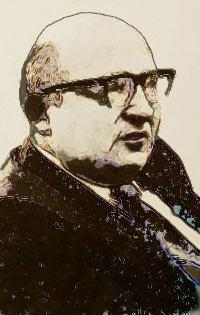 The
Thunderjet motor was designed by innovative English engineer Derek Brand,
who deserves to be ranked with Joshua Lionel Cowen, A.C. Gilbert, Frank
Hornby, and Louis Marx as one of the great benefactors to boyhood in the
20th Century. The T-jet's 'pancake' motor with its flat armature, vertical
shaft and train of gears along the top, was an amazingly elegant piece
of miniature design. It was fast, reliable, adaptable to a variety of
body styles, and could be modified by the average boy mechanic for even
better performance. Introduced in 1963, the T-jets immediately supplanted
Aurora's first generation HO slotcar, an even more original (but slower
and more troublesome) design by Brand involving a vibrating reed and splined
axle. They also left Aurora's competitors, with their inline can-motors,
in the dust. The
Thunderjet motor was designed by innovative English engineer Derek Brand,
who deserves to be ranked with Joshua Lionel Cowen, A.C. Gilbert, Frank
Hornby, and Louis Marx as one of the great benefactors to boyhood in the
20th Century. The T-jet's 'pancake' motor with its flat armature, vertical
shaft and train of gears along the top, was an amazingly elegant piece
of miniature design. It was fast, reliable, adaptable to a variety of
body styles, and could be modified by the average boy mechanic for even
better performance. Introduced in 1963, the T-jets immediately supplanted
Aurora's first generation HO slotcar, an even more original (but slower
and more troublesome) design by Brand involving a vibrating reed and splined
axle. They also left Aurora's competitors, with their inline can-motors,
in the dust.
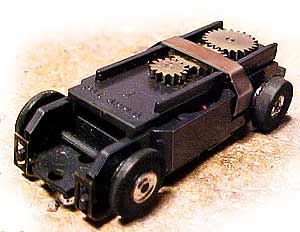 For
8 years, Aurora's T-jets remained the fastest and by far the best-selling
HO slotcars on the market, being produced in enormous quantities. In 1971,
to meet the challenge of the new, fast Tyco cars, Aurora launched a crash
program to introduce the third generation HO slotcar, the AFX. The AFX
were substantially faster than the T-jets, and much more stable on curves,
with wide tires and a deep guide flange as standard equipment. For
8 years, Aurora's T-jets remained the fastest and by far the best-selling
HO slotcars on the market, being produced in enormous quantities. In 1971,
to meet the challenge of the new, fast Tyco cars, Aurora launched a crash
program to introduce the third generation HO slotcar, the AFX. The AFX
were substantially faster than the T-jets, and much more stable on curves,
with wide tires and a deep guide flange as standard equipment.
Overnight, T-jets were obsolete.
Thousands of them were sold at closeout prices and in novelty sets, but
enormous quantities of running chassis and parts remained in warehouses,
and are still available as 'new old stock' thirty years later.
Through the years, as Aurora
and Tyco battled for the title of "fastest slotcar," speeds
steadily climbed. The AFX and its successors acquired powerful low-slung
magnets whose attraction to the track's power-rails made them hold the
corners at all but the very highest speeds. As scale speeds literally
exceeded the supersonic, many people began to feel that the new supercars
were impressive engineering achievements but, overall, not as much fun
to race as the slower, unsophisticated, slippery old Thunderjets and early
AFXs.
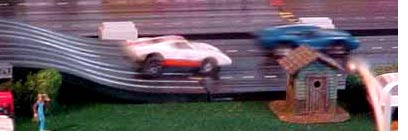 Today,
so many people are still interested in racing the forty-year-old T-jet
technology that in the late '90s the popular Johnny Lightning line
of small car-models was expanded to include near-exact copies of the late
production Thunderjet motors with both replica- and new-style plastic
bodies. A flourishing garage-industry provides resin-cast bodies of historical
cars made to fit the old (and new) T-jet chassis. Serious competitors
race in a T-jet class, which uses original specification chassis with
limited modifications allowed, and on thousands of home tracks, Derek
Brand's amazing little cars still buzz down the straightaways and fishtail
around the corners to the delight of their original owners and their children
and grandchildren alike. Today,
so many people are still interested in racing the forty-year-old T-jet
technology that in the late '90s the popular Johnny Lightning line
of small car-models was expanded to include near-exact copies of the late
production Thunderjet motors with both replica- and new-style plastic
bodies. A flourishing garage-industry provides resin-cast bodies of historical
cars made to fit the old (and new) T-jet chassis. Serious competitors
race in a T-jet class, which uses original specification chassis with
limited modifications allowed, and on thousands of home tracks, Derek
Brand's amazing little cars still buzz down the straightaways and fishtail
around the corners to the delight of their original owners and their children
and grandchildren alike.
|
